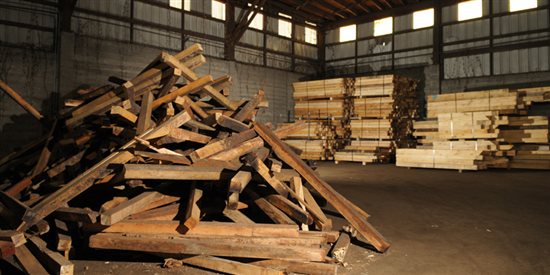We may receive a commission when you use our affiliate links. However, this does not impact our recommendations.

A tiny Powder Post Beetle doing some trapeze acrobatics on the tip of my pencil after emerging form the wood.
Commercial bought lumber, such as the one found in lumber yards and in the big-box stores is almost always guaranteed to be kiln dried. This means that the lumber was heated in a kiln in order to reduce its moisture content, or in other words, was forced to vapor out unwanted water, both from inside the cells and in between them. But transforming green wood boards from moist to dry has another important reason — the eradication of critters. You see, the combination of heat and a reduction of moisture inhibits the presence of Powderpost beetles, termites and other wood borrower insects. Research and experience has shown that those tiny wood munchers cannot survive in timber who’s moisture content is below 8-12%.

 In my book Working Reclaimed Wood, I talk about wood pests and the ways in which we can reduce moisture content in reclaimed wood in order to pacify it from these invaders. One of these techniques, which I’ve been using occasionally on green wood, is to place small reclaimed workpieces in the microwave for a few minutes, three or four times a day and until the wood is dry enough. The microwaves penetrate deep into the wood, agitate the water molecules and consequently heat them up, which induce evaporation and migration of water out of the wood. Since insects cells and bodies contain water, the microwave practically cooks them up.
In my book Working Reclaimed Wood, I talk about wood pests and the ways in which we can reduce moisture content in reclaimed wood in order to pacify it from these invaders. One of these techniques, which I’ve been using occasionally on green wood, is to place small reclaimed workpieces in the microwave for a few minutes, three or four times a day and until the wood is dry enough. The microwaves penetrate deep into the wood, agitate the water molecules and consequently heat them up, which induce evaporation and migration of water out of the wood. Since insects cells and bodies contain water, the microwave practically cooks them up.
But what options are at our disposal when we need to treat substantial reclaimed timber, such as posts and beams from a derelict barn for instance? What can we do if we don’t have access to a kiln (commercial or makeshift) or a behemoth microwave? One such option, which I stumbled upon when conducting the research for the book — lets call is the “Star War option” — is the brainchild of a Ukrainian inventor who claims to solve all our bug problems with a bang. Boris Eresko has came up with an ingenious technique to generate strong microwave radiation that can penetrate massive beams and logs up to 15 inches thick.

Boris Eresko’s Microwave device is promised to eradicate insects and larvae who invaded your timber frame home.
This allows us to use the device on post and beam timber, green wood logs or any wood that spent some time outside and/or is suspected of being infested with insects. The device is made of two aluminum boxes: one emits the microwave radiation while the other provides the power source. To begin the eradication the emitter box is placed in front of the infested wood. Then the operator steps back and turns on the device. The amount of time that the timber needs to be” zapped” depends on the thickness of the timber, but if your log or beam is thicker than 15 inches you can aim another microwave emitter from the other side and let both work together. This contraption allows carpenters, sculptors and anyone who uses massive reclaimed timber to get to work on their projects shortly after frying the bugs, and allow any projects that relies on green wood, reclaimed wood or air dried wood to be thoroughly treated before entering our home.
After discovering Mr. Eresko galactic microwave, I learned about yet another device, this time a British product called Gibbs Sandtech Wood Welder.
This handheld gizmo is intended to expedite the subterranean drying of water-based wood glues in joints via radio waves which penetrate the surface in order to heat and dry the glue. When I contacted the company director, Warren Gibbs, he told me that he had heard about people who used the device to kill insects in wood. Mr. Gibbs revealed that the Wood Welder can penetrate up to 1-¼” deep into the board, and that the company recommend that the lumber moisture content should not exceed 12-14%. If the moisture content is higher than this, the device will have to be deployed for much longer periods of time, toiling on vaporizing the excessive moisture and only then affecting the bugs.
Although I was initially thrilled about the idea of including the information on these fantastic microwave and radio wave innovations in the book, I ended up leaving it out. The thing is that when we edited the chapter, Processing Reclaimed Wood, we realized that these machines are quite expensive and that neither I nor my book editor, A.J. Hamler, or people from the reclaimed wood world that I talked to or read about, had mentioned them. So for the sake of prudence, we decided to keep it out and wait until I can gather some more information, anecdotes, and maybe even some personal experience, which will allow me to safely reinstall these machines inside the pages of the future second edition of my book.
– Yoav Liberman
Here are some supplies and tools we find essential in our everyday work around the shop. We may receive a commission from sales referred by our links; however, we have carefully selected these products for their usefulness and quality.








